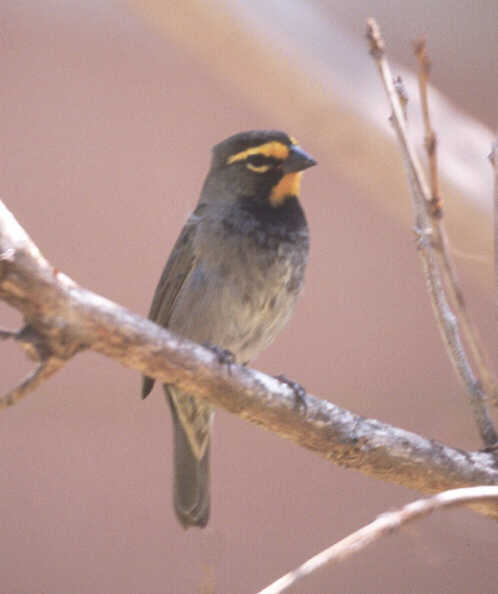
Yellow-faced Grassquit,
an attractive bird, pleasantly common throughout Cuba.
photo © Ken McKenna, 2000
1 - 13 April 2000
by Blake Maybank

Yellow-faced Grassquit,
an attractive bird, pleasantly common throughout Cuba.
photo © Ken McKenna, 2000
In April 2000, the Nova Scotia Bird Society undertook a tour of the Cuba Oriente, the eastern mountains of Cuba. The trip was run as a fund-raiser, and more than $2000 was raised for the Society. Our group of 12 assembled at the Halifax International Airport on the evening of March 31st. The Air Transat flight left on time, and arrived punctually in Holguin, Cuba, just over four hours later. Customs was a smooth procedure, all the baggage dutifully appeared, and we were on our buses to the hotel within an hour of arrival. Just over 60 minutes later we arrived at our Cuban base of operations, the Las Brisas resort in Guardalavaca.
[Note: For further background on the Guardalavaca area, please read my report from December 1998 (click here). I've updated the following background information from that report.]
INDEX OF PHOTOGRAPHS:
1) -- Moon Handbooks: Cuba by Christopher P. Baker.
Published by Moon Travel Handbooks. The BEST Guidebook available.
2) -- Field Guide to the Birds of Cuba by Orlando H. Garrido, Arturo Kirkconnell, Roman F. Company. Very useful.
3) -- "A Guide to the Birds of the West Indies", 1998,
by Herbert Raffaele, et al., published by Princeton University
Press. Excellent resource, although not a pocket guide. It
fit in my backpack, though, and accompanied us on our outings.
This book now supercedes the following old standby...
4) -- "A Field Guide to the Birds of the West Indies", by Bond, (James Bond), published by Houghton Mifflin. A useful, but not essential, back-up reference.
Health:
We had no problems with food or water, and at all our hotels could drink safely from the taps. No particular vaccinations or inoculations were required.
Pests:
We encountered few mosquitoes, and no chiggers.
Weather:
The temperature was in the high 20's to low 30's every day, and cooler in the evening. Breezes along the coast were frequent, but as the drought persisted, we only had one heavy rain shower during our stay.
Safety:
We had no experience with big-city Cuban life, but in the countryside, and around the resorts in which we stayed, we experienced no problems at all. There was essentially no begging, although in the Guardalavaca area there were some people willing to sell you cigars or sea-shells, but they weren't pushy or obnoxious. By contrast, most people were friendly and curious. None of us ever felt at risk. We kept our valuables locked in our hotel-room safe, and had no troubles.
Money:
Most of the in-country tours can be paid for with credit cards, as can expenses incurred through hotels. Getting more money from the local bank presented no difficulty. U.S. dollars are the currency of choice in-country. You cannot use any credit cards linked with U.S. banks, nor anything connected to American Express, including their travellers cheques. Outside hotels it's generally cash only.
Other Recommendations:
Canadians are very much in the habit of bringing items into Cuba which are in short supply locally, and distributing them as tips to staff, or simply giving them to families or people one encounters as one roams the countryside. T-shirts and baseball caps are frequently left behind, but children's clothing is much desired, as are school supplies (pencils, crayons, pens, paper), soap and toiletries, tampons, etc. Even our empty plastic water bottles were welcome. From within the hotels the extent of the shortages in the countryside isn't especially obvious, but it is real. Take into the country as much as will fit in your suitcases, and replace it for the homeward trip with coffee, artwork, cigars, and rum. And wonderful memories. It seems a fair trade.
Our Day by Day Trip Experiences
April 1
We birded in the Guardalavaca area in the morning, and I worked with the Cuban in-tourist agency Cubanacan that afternoon regarding our in-country excursions we had previously arranged. I learned to my dismay that our planned overnight trip to Pinares de Mayarí would not be possible due to a local water shortage (Cuba was in a prolonged (10 month-long) drought). So, with the group's approval, I rejigged our schedule in order to continue to have two overnight trips in the first week, as one of our participants could only stay for a single week. The reorganisation meant, however, a busier than intended first few days.
In the meantime we had the Guardalavaca area to explore, and we revisited a small marsh SW of the town, and discovered rather wanting for water, although we did see a Purple Gallinule and a King Rail, and there were numerous herons and egrets about. During the course of our stay the marsh grew increasingly dry, until the water completely evaporated -- we nick-named the site the "Vanishing Marsh."
There is a large wooded ravine and mangrove to the immediate west of the village of Guardalavaca, which is protected as a small national park, due to some rare plants. Perhaps due to the drought, this was a major concentration spot for resident and overwintering birds, and repeated visits there resulted in numerous sightings, including Cuban Green Woodpecker, Worm-eating Warblers, our first of three intimate looks at a confiding Mangrove Cuckoo, and a small colony of Yellow-crowned Night-Herons. And there were always many wood warblers to attract our attention.
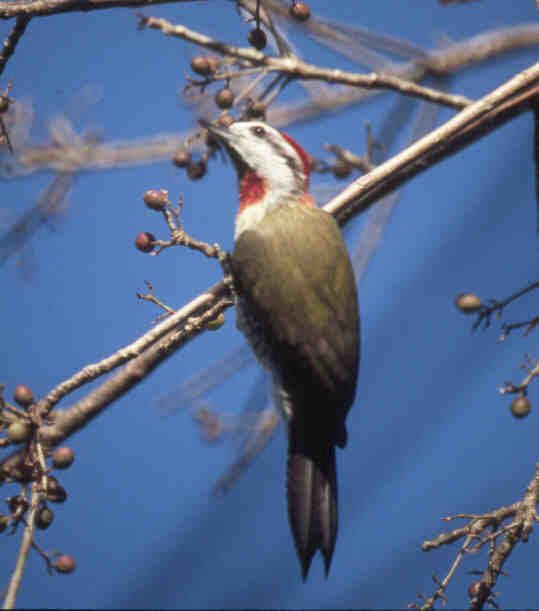 - - Guardalavaca images
- -
- - Guardalavaca images
- - 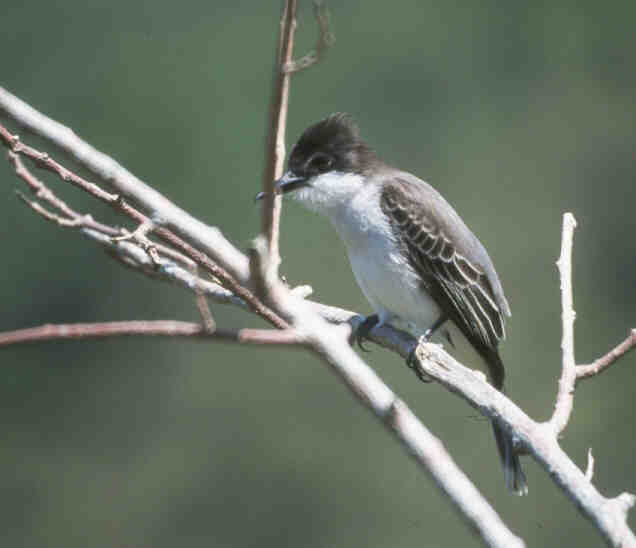
Cuban
Woodpecker
Eastern Kingbird
photo © Ken McKenna,
2000
photo © Ken McKenna, 2000
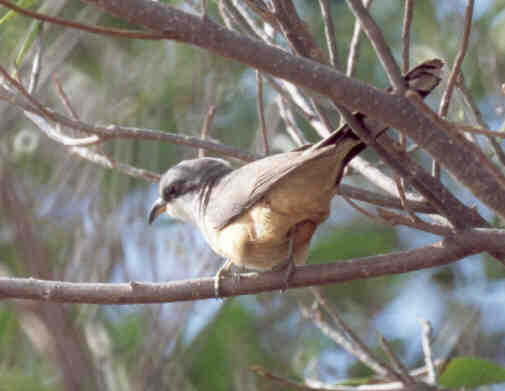
A Mangrove Cuckoo
forgetting to skulk
photo © Ken McKenna, 2000
Just to the east of the Las Brisas resort was a small mangrove, bisected by a gravel path, and a site just south of the path became known to us as "The Warbler Hole", wherein, especially in the two hours before dusk, many warblers could be seen flycatching for insects, including a single Oriente Warbler, who showed himself to all that were interested, with the frustrating exception of Pat, who was required to return to "The Hole" repeatedly each evening, before finally connecting with the warbler on the second last night.
This was also the spot where a few overwintering Least and Solitary Sandpipers could be seen any time of day.
The mangrove itself was a night roost for several hundred egrets and herons, mostly Cattle Egrets, but also including Great and Snowy Egrets, Yellow-crowned Night-Herons, and Little Blue Herons. We gathered on my balcony most evenings with rum drinks in hand, to watch the evening arrival flight, and see what else might be around. In this manner we also had balcony sightings of West Indian Whistling-Ducks, a Crested Caracara, and a Peregrine Falcon.
The Las Brisas Resort
in
Guardalavaca
photo © Joan Waldron, 2000
Other birds in the Guardalavaca area were noted in the following areas: along the beach to the east of the resort; in the water supply reservoir for the town; and along a limestone-surfaced trail that headed east along the coast, a path we called "The Coral Trail". This latter trail was quieter than my previous visit one year earlier, likely because of the drought.
Playa Guardalavaca -- Bird Sightings
31 March - 13 April 2000
LEGEND
# days = number of days a species was encountered.
Max = maximum daily count for species in Playa Guardalavaca.
D = species was seen/assumed to be present daily.
| COMMON NAME | SCIENTIFIC NAME | # days | Max | COMMENTS |
| Least Grebe | Tachybaptus dominicus | D | 9 | At Reservoir |
| Brown Pelican | Pelecanus occidentalis | 4 | 1 | - |
| West Indian Whistling-Duck | Dendrocygna arborea | 2 | 4 | - |
| Ruddy Duck | Oxyura jamaicensis | D | 10 | At Reservoir |
| Tricolored Heron | Egretta tricolor | 4 | 2 | - |
| Little Blue Heron | Egretta caerulea | 4 | 4 | - |
| Snowy Egret | Egretta thula | D | 30 | - |
| Great Egret | Ardea alba | 4 | 3 | - |
| Cattle Egret | Bubulcus ibis | D | 200 | - |
| Green Heron | Butorides virescens | 5 | 5 | - |
| Yellow-crowned Night-Heron | Nyctanassa violacea | D | 10 | - |
| Turkey Vulture | Cathartes aura | D | 50 | - |
| Crested Caracara | Caracara plancus | 1 | 1 | Apr 1, 2000, fly-by |
| American Kestrel | Falco sparverius | D | 4 | - |
| Peregrine Falcon | Falco peregrinus | 3 | 1 | - |
| King Rail | Rallus elegans | 1 | 1 | Apr 1, 2000 |
| Purple Gallinule | Porphyrio martinicus | 1 | 1 | Apr 1, 2000 |
| Common Moorhen | Gallinula chloropus | D | 4 | - |
| American Coot | Fulica americana | D | 5 | At Reservoir |
| Greater Yellowlegs | Tringa melanoleuca | 3 | 1 | - |
| Solitary Sandpiper | Tringa solitaria | D | 3 | - |
| Spotted Sandpiper | Tringa macularia | D | 3 | - |
| Ruddy Turnstone | Arenaria interpres | 2 | 13 | - |
| Least Sandpiper | Calidris minutilla | D | 7 | - |
| Black-necked Stilt | Himantopus mexicanus | D | 8 | At Reservoir |
| Semipalmated Plover | Charadrius semipalmatus | 1 | 1 | Apr 6, 2000 |
| Killdeer | Charadrius vociferus | D | 3 | - |
| Laughing Gull | Larus atricilla | 2 | 1 | - |
| Royal Tern | Sterna maxima | 4 | 2 | - |
| Rock Dove | Columba livia | D | 30 | - |
| Mourning Dove | Zenaida macroura | D | 50 | - |
| Zenaida Dove | Zenaida aurita | 2 | 8 | - |
| White-winged Dove | Zenaida asiatica | D | 4 | - |
| Common Ground-Dove | Columbina passerina | D | 10 | - |
| Mangrove Cuckoo | Coccyzus minor | 3 | 1 | - |
| Great Lizard-Cuckoo | Saurothera merlini | 3 | 1 | - |
| Smooth-billed Ani | Crotophaga ani | D | 30 | - |
| Antillean Nighthawk | Chordeiles gundlachii | 1 | 1 | Apr 1, 2000 |
| Antillean Palm-Swift | Tachornis phoenicobia | 3 | 2 | - |
| Cuban Emerald | Chlorostilbon ricordii | D | 10 | - |
| Belted Kingfisher | Ceryle alcyon | 4 | 2 | - |
| Cuban Green Woodpecker | Xiphidiopicus percussus | 3 | 2 | - |
| Gray Kingbird | Tyrannus dominicensis | D | 20 | - |
| Loggerhead Kingbird | Tyrannus caudifasciatus | 1 | 1 | Apr 11, 2000 |
| Cuban Vireo | Vireo gundlachii | D | 5 | - |
| Black-whiskered Vireo | Vireo altiloquus | D | 20 | - |
| Warbling Vireo | Vireo gilvus | 2 | 1 | - |
| Red-legged Thrush | Turdus plumbeus | D | 20 | - |
| Gray Catbird | Dumetella carolinensis | 2 | 1 | - |
| Northern Mockingbird | Mimus polyglottos | D | 50 | - |
| Bank Swallow | Riparia riparia | 1 | 8 | Apr 1, 2000 |
| Barn Swallow | Hirundo rustica | 1 | 1 | Apr 1, 2000 |
| Cave Swallow | Hirundo fulva | 1 | 10 | Apr 10, 2000 |
| House Sparrow | Passer domesticus | D | 50 | - |
| Northern Parula | Parula americana | D | 20 | - |
| Yellow Warbler | Dendroica petechia | D | 10 | - |
| Cape May Warbler | Dendroica tigrina | D | 100 | - |
| Black-throated Blue Warbler | Dendroica caerulescens | D | 30 | - |
| Blackburnian Warbler | Dendroica fusca | 1 | 1 | Apr 1, 2000 |
| Yellow-throated Warbler | Dendroica dominica | 3 | 1 | - |
| Prairie Warbler | Dendroica discolor | D | 8 | - |
| Palm Warbler | Dendroica palmarum | D | 10 | - |
| Black-and-white Warbler | Mniotilta varia | D | 5 | - |
| American Redstart | Setophaga ruticilla | D | 20 | - |
| Worm-eating Warbler | Helmitheros vermivorus | D | 2 | - |
| Ovenbird | Seiurus aurocapillus | D | 6 | - |
| Northern Waterthrush | Seiurus noveboracensis | D | 7 | - |
| Louisiana Waterthrush | Seiurus motacilla | D | 3 | - |
| Common Yellowthroat | Geothlypis trichas | D | 5 | - |
| Oriente Warbler | Teretistris fornsi | D | 1 | - |
| Hooded Warbler | Wilsonia citrina | 2 | 1 | - |
| Stripe-headed Tanager | Spindalis zena | 1 | 2 | - |
| Cuban Grassquit | Tiaris canora | 1 | 1 | Apr 8, 2000 |
| Yellow-faced Grassquit | Tiaris olivacea | D | 30 | - |
| Indigo Bunting | Passerina cyanea | D | 6 | - |
| Painted Bunting | Passerina ciris | D | 2 | - |
| Black-cowled Oriole | Icterus dominicensis | 3 | 4 | - |
| Tawny-shouldered Blackbird | Agelaius humeralis | D | 15 | - |
| Eastern Meadowlark | Sturnella magna | 1 | 2 | - |
| Cuban Blackbird | Dives atroviolacea | D | 20 | - |
| Greater Antillean Grackle | Quiscalus niger | D | 100 | - |
April 2
The entire group, less Joanne and Jack, undertook a day-long drive from Guardalavaca to Barracoa, along the coast highway (Joanne and Jack chose to forego the drive, and decided to use a helicopter to visit Barracoa on April 3rd.). It was a very pleasant drive, except for rough roads between Banes and Mayarí, and the ecological devastation around Moa, where there are several nickel mines. In the morning the best sighting was two Limpkins foraging in the open in a ploughed field. The road from Moa to Barracoa, reputed to be bad, was unpaved, but reasonable. We birded (and ate a picnic lunch) along this stretch, and some good sightings included Cuban Crows and Antillean Palm-Swifts.

Lunch at Rio
Nibujonen enroute to Barracoa
photo © Blake
Maybank, 2000
That evening, before supper, we birded along the Rio Toa, and encountered heavy rain showers, but it was a warm rain. We found an Eastern/Western Wood-Pewee that refused to call, leaving its specific identity a mystery -- either species is very rare in Cuba.
In Barracoa we stayed at the Castillo Hotel, very decent, and with a great view. The food, as throughout our trip, was very good. A local carnival was in progress, and the festivities did not end until dawn, but no-one complained of being unable to sleep -- the air conditioners provided a reasonable substitute for white noise.
Drive from Guardalavaca to Barracoa -- Bird Sightings
2 April 2000
| COMMON NAME | SCIENTIFIC NAME | # SEEN | SPECIFIC LOCALE |
| Little Blue Heron | Egretta caerulea | 1 | Rio Toa |
| Little Blue Heron | Egretta caerulea | 2 | - |
| Snowy Egret | Egretta thula | 10 | - |
| Great Blue Heron | Ardea herodias | 1 | - |
| Great Egret | Ardea alba | 6 | - |
| Cattle Egret | Bubulcus ibis | 500 | - |
| Turkey Vulture | Cathartes aura | 100 | - |
| American Kestrel | Falco sparverius | 8 | - |
| Limpkin | Aramus guarauna | 2 | Herrera |
| Spotted Sandpiper | Tringa macularia | 1 | Rio Toa |
| Rock Dove | Columba livia | 50 | - |
| White-crowned Pigeon | Columba leucocephala | 2 | Rio Nibujon |
| Scaly-naped Pigeon | Columba squamosa | 4 | Rio Toa |
| Mourning Dove | Zenaida macroura | 100 | - |
| Zenaida Dove | Zenaida aurita | 2 | Rio Toa |
| White-winged Dove | Zenaida asiatica | 2 | Bahia de Taco |
| Common Ground-Dove | Columbina passerina | 12 | - |
| Great Lizard-Cuckoo | Saurothera merlini | 1 | Rio Toa |
| Smooth-billed Ani | Crotophaga ani | 6 | - |
| Antillean Palm-Swift | Tachornis phoenicobia | 10 | Yamanigev |
| Cuban Emerald | Chlorostilbon ricordii | 5 | Rio Toa |
| Belted Kingfisher | Ceryle alcyon | 1 | Rio Toa |
| Belted Kingfisher | Ceryle alcyon | 1 | - |
| Cuban Woodpecker | Xiphidiopicus percussus | 3 | Rio Toa |
| Cuban Woodpecker | Xiphidiopicus percussus | 2 | Bahia de Taco |
| Eastern/Western Wood-Pewee | Contopus sp. | 1 | Rio Toa |
| Gray Kingbird | Tyrannus dominicensis | 30 | - |
| Cuban Crow | Corvus nasicus | 3 | Punta Gorda |
| Cuban Vireo | Vireo gundlachii | 2 | Bahia de Taco |
| Black-whiskered Vireo | Vireo altiloquus | 10 | - |
| Red-legged Thrush | Turdus plumbeus | 20 | Rio Toa |
| Northern Mockingbird | Mimus polyglottos | 50 | - |
| Cave Swallow | Hirundo fulva | 30 | Rio Toa |
| House Sparrow | Passer domesticus | 50 | - |
| Northern Parula | Parula americana | 3 | Rio Toa |
| Cape May Warbler | Dendroica tigrina | 3 | Rio Toa |
| Black-throated Blue Warbler | Dendroica caerulescens | 2 | Rio Nibujon |
| Black-throated Blue Warbler | Dendroica caerulescens | 2 | Rio Toa |
| Yellow-throated Warbler | Dendroica dominica | 1 | Rio Nibujon |
| Palm Warbler | Dendroica palmarum | 1 | Rio Toa |
| Black-and-white Warbler | Mniotilta varia | 2 | Rio Toa |
| American Redstart | Setophaga ruticilla | 3 | Rio Toa |
| American Redstart | Setophaga ruticilla | 2 | - |
| Louisiana Waterthrush | Seiurus motacilla | 2 | Rio Nibujon |
| Common Yellowthroat | Geothlypis trichas | 2 | - |
| Yellow-faced Grassquit | Tiaris olivacea | 20 | - |
| Black-cowled Oriole | Icterus dominicensis | 8 | Rio Toa |
| Tawny-shouldered Blackbird | Agelaius humeralis | 3 | - |
| Eastern Meadowlark | Sturnella magna | 20 | - |
| Cuban Blackbird | Dives atroviolacea | 4 | Rio Toa |
| Cuban Blackbird | Dives atroviolacea | 10 | - |
| Greater Antillean Grackle | Quiscalus niger | 10 | Rio Toa |
| Greater Antillean Grackle | Quiscalus niger | 200 | - |
April 3
We discovered that a hike up El Yunqué was not practical, as it would require clear skies, and all day (and good fitness).
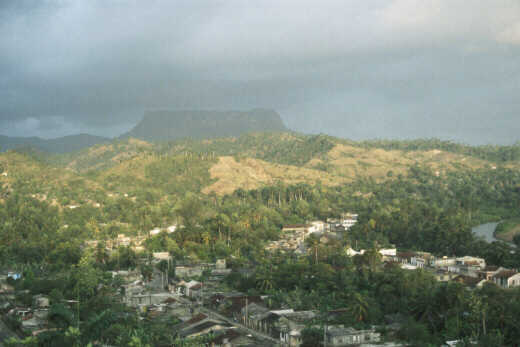
No clear skies over El Yunqué
photo © Blake
Maybank, 2000
Instead, we birded along the road to El Yunqué, and among the many birds we encountered, the highlights were very close looks at Cuban Trogons, the country's national bird, as well as some White-collared Swifts. We saw many Green Woodpeckers, including a couple of nests, and there were several more Cuban Crows. Scaly-naped Pigeons were also a good find.
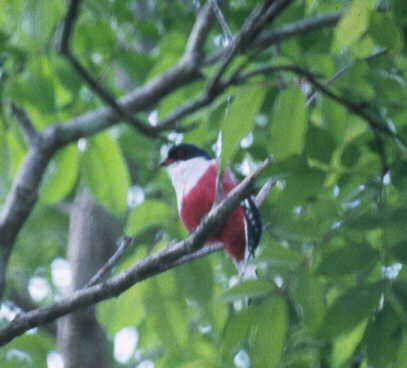
Cuban Trogan,
the
country's national bird
photo © Ken McKenna, 2000
Later in the morning, we visited a "typical" Cuban farm, the same site visited by the typical helicopter tours to Barracoa (we were the first group to drive to Barracoa along the north shore in more than two years).
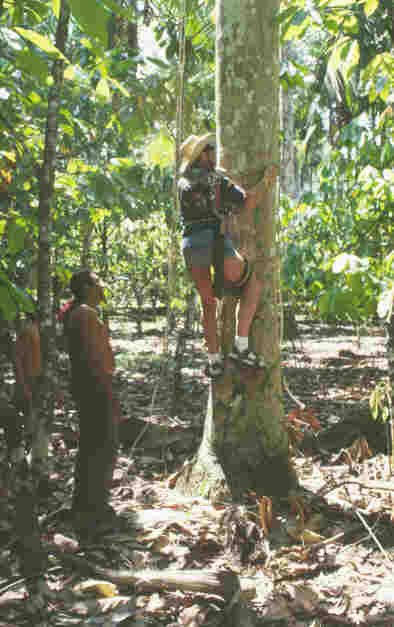 - - Images
from the Rio Toa road - -
- - Images
from the Rio Toa road - - 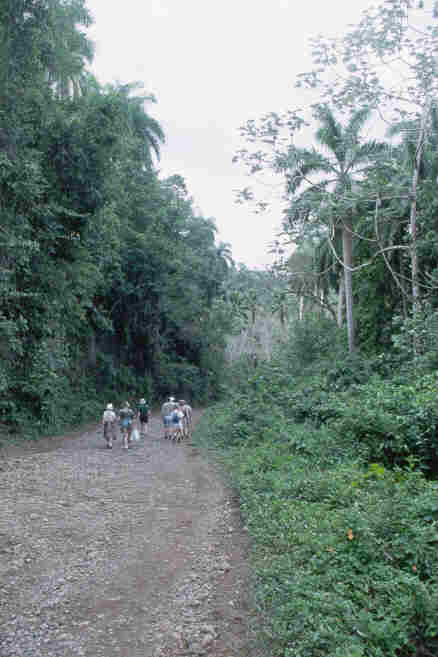
Mad McKay attempts to secure some coconuts. Birding along the Rio Toa road.
photos © Ken McKenna, 2000
As we were walking out we passed Joanne & Jack and their group who were being driven in to the farm. We had a lunch (slightly delayed) at a fine site beside the Rio Toa, where helicopter participants take a boat ride on the river. We enjoyed our roast suckling pig, and saw a West Indian Woodpecker, the only one of the trip.
A Gray Kingbird, a frequent companion.  photo ©
Ken McKenna, 2000
photo ©
Ken McKenna, 2000
We drove back to Guardalavaca in the p.m., arriving around suppertime, stopping en route at an intriguing-looking small lake, which turned out to be almost empty of birdlife..
We had a comfortable mini-van from Cubanacan for this trip; they also supplied a driver, and a bilingual guide, Sonia Valdés, who did a wonderful job.
3 April 2000 Bird Sightings
El Yunque Road
| COMMON NAME | SCIENTIFIC NAME | # SEEN |
| Turkey Vulture | Cathartes aura | 10 |
| American Kestrel | Falco sparverius | 2 |
| Peregrine Falcon | Falco peregrinus | 1 |
| White-crowned Pigeon | Columba leucocephala | 2 |
| Scaly-naped Pigeon | Columba squamosa | 2 |
| Mourning Dove | Zenaida macroura | 80 |
| Zenaida Dove | Zenaida aurita | 2 |
| White-winged Dove | Zenaida asiatica | 2 |
| Common Ground-Dove | Columbina passerina | 10 |
| Great Lizard-Cuckoo | Saurothera merlini | 1 |
| Smooth-billed Ani | Crotophaga ani | 7 |
| White-collared Swift | Streptoprocne zonaris | 2 |
| Cuban Emerald | Chlorostilbon ricordii | 15 |
| Cuban Trogon | Priotelus temnurus | 2 |
| Belted Kingfisher | Ceryle alcyon | 2 |
| Cuban Woodpecker | Xiphidiopicus percussus | 10 |
| Eastern Kingbird | Tyrannus tyrannus | 2 |
| Gray Kingbird | Tyrannus dominicensis | 20 |
| Cuban Crow | Corvus nasicus | 6 |
| Black-whiskered Vireo | Vireo altiloquus | 30 |
| Red-legged Thrush | Turdus plumbeus | 40 |
| Northern Parula | Parula americana | 3 |
| Black-throated Blue Warbler | Dendroica caerulescens | 3 |
| Palm Warbler | Dendroica palmarum | 3 |
| Black-and-white Warbler | Mniotilta varia | 1 |
| American Redstart | Setophaga ruticilla | 12 |
| Yellow-faced Grassquit | Tiaris olivacea | 20 |
| Black-cowled Oriole | Icterus dominicensis | 6 |
| Tawny-shouldered Blackbird | Agelaius humeralis | 1 |
| Cuban Blackbird | Dives atroviolacea | 10 |
| Greater Antillean Grackle | Quiscalus niger | 200 |
Rio Toa (Lunch Stop)
| COMMON NAME | SCIENTIFIC NAME | # SEEN |
| Cuban Woodpecker | Xiphidiopicus percussus | 2 |
| West Indian Woodpecker | Melanerpes superciliaris | 1 |
Drive from Barracoa to Guardalavaca
| COMMON NAME | SCIENTIFIC NAME | # SEEN |
| Pied-billed Grebe | Podilymbus podiceps | 2 |
| Ruddy Duck | Oxyura jamaicensis | 1 |
| Little Blue Heron | Egretta caerulea | 2 |
| Snowy Egret | Egretta thula | 5 |
| Great Blue Heron | Ardea herodias | 2 |
| Cattle Egret | Bubulcus ibis | 300 |
| Green Heron | Butorides virescens | 3 |
| Yellow-crowned Night-Heron | Nyctanassa violacea | 1 |
| Turkey Vulture | Cathartes aura | 100 |
| American Kestrel | Falco sparverius | 10 |
| American Coot | Fulica americana | 4 |
| Spotted Sandpiper | Tringa macularia | 4 |
| Killdeer | Charadrius vociferus | 2 |
| Rock Dove | Columba livia | 50 |
| Mourning Dove | Zenaida macroura | 100 |
| Smooth-billed Ani | Crotophaga ani | 13 |
| Gray Kingbird | Tyrannus dominicensis | 20 |
| Black-whiskered Vireo | Vireo altiloquus | 5 |
| Red-legged Thrush | Turdus plumbeus | 20 |
| Northern Mockingbird | Mimus polyglottos | 15 |
| Cave Swallow | Hirundo fulva | 50 |
| House Sparrow | Passer domesticus | 30 |
| Black-cowled Oriole | Icterus dominicensis | 4 |
| Greater Antillean Grackle | Quiscalus niger | 100 |
April 4
We were up early for the drive to El Saltón. We happened upon a great roadside marsh in a rice field just north of Cauto Christo, filled with birds (we stopped there on our way back, as well). There were many herons and egrets, and numerous Northern Jacanas and Black-necked Stilts, but the prize was two immature Snail Kites that gave a great show, including the capture and dispatch of several snails.
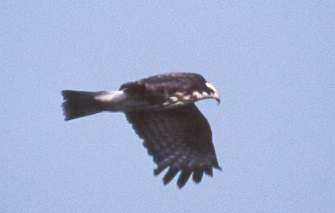
Snail Kite over rice
field, Cauto Christo
photo © Ken McKenna, 2000
We were in El Saltón for lunch, and met with Ricardo Sosa, who spent the afternoon, evening, and following morning with us. He was excellent, as usual. Everyone enjoyed the resort, the lodge was in fine shape, and the meals were very good.
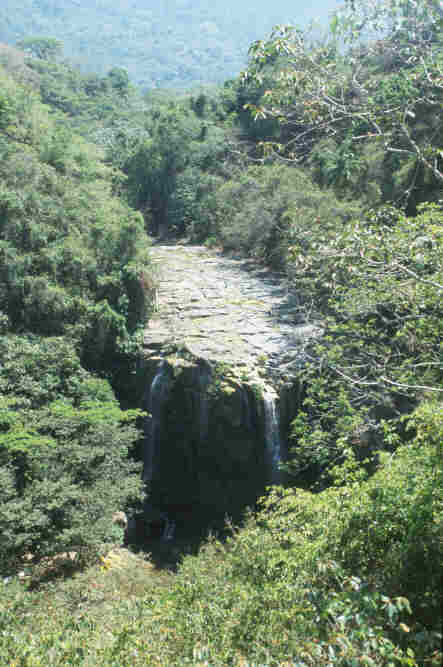 < El Saltón >
< El Saltón > 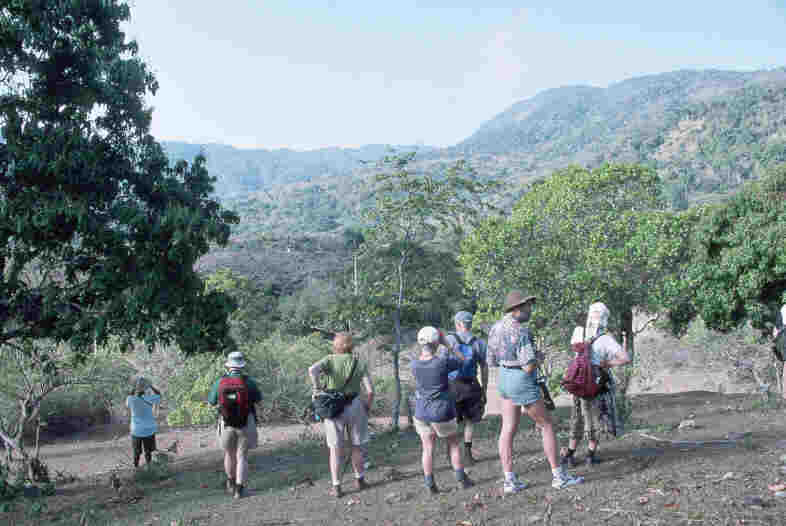
The Waterfall at El Saltón. Birding the hills above El Saltón
photos © Ken McKenna, 2000
We had both Bare-legged Owls and Cuban Pygmy-Owls here, and part of our group who left the afternoon hike early had a Grundlach's Hawk on the way back to the resort. Other birds here the group enjoyed included Ruddy Quail-Dove, Red-legged Honeycreeper, Cuban Pewee, (Cuban) Eastern Meadowlark, many Cuban Grassquits, N. Rough-winged Swallow, Cuban Bullfinch, and my favourite Caribbean bird of all, the Cuban Tody.
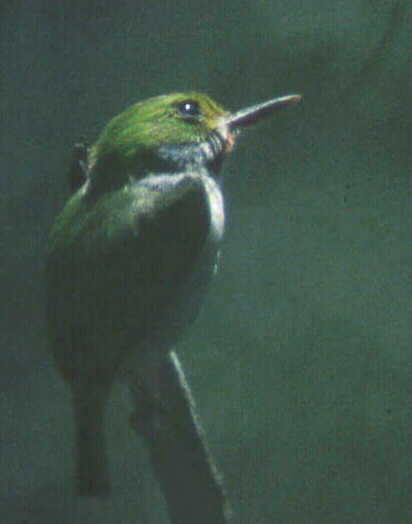
The Cuban Tody, Todus
multicolor, my favourite Cuban bird
photo © Blake
Maybank, 2000
April 5
We birded the hills around El Saltón in the morning, and had a fine roast pig luncheon beside the waterfall before we left for Guardalavaca.
We arrived in mid-to-late afternoon in Guardalavaca. As before, Cubanacan supplied the driver, and our guide this time was Raoul, who was also very good.
4-5 April Bird Sightings
El Saltón
Afternoon and evening of April 4th
Morning of April 5th
| COMMON NAME | SCIENTIFIC NAME | # OBSERVED | |
| 4 April | 5 April | ||
| Least Grebe | Tachybaptus dominicus | - | 1 |
| Little Blue Heron | Egretta caerulea | - | 2 |
| Green Heron | Butorides virescens | - | 1 |
| Yellow-crowned Night-Heron | Nyctanassa violacea | 2 | - |
| Turkey Vulture | Cathartes aura | 5 | 10 |
| Red-tailed Hawk | Buteo jamaicensis | 3 | 1 |
| Gundlach's Hawk | Accipiter gundlachi | 1 | - |
| American Kestrel | Falco sparverius | 4 | 3 |
| Peregrine Falcon | Falco peregrinus | - | 1 |
| Purple Gallinule | Porphyrio martinicus | - | 1 |
| Killdeer | Charadrius vociferus | 2 | - |
| Rock Dove | Columba livia | 20 | 20 |
| Scaly-naped Pigeon | Columba squamosa | - | 2 |
| Mourning Dove | Zenaida macroura | 40 | 20 |
| Zenaida Dove | Zenaida aurita | - | 1 |
| White-winged Dove | Zenaida asiatica | 2 | 10 |
| Common Ground-Dove | Columbina passerina | 10 | 10 |
| Ruddy Quail-Dove | Geotrygon montana | - | 4 |
| Great Lizard-Cuckoo | Saurothera merlini | 4 | 2 |
| Smooth-billed Ani | Crotophaga ani | 20 | 20 |
| Bare-legged Owl | Otus lawrencii | 2 | - |
| Cuban Pygmy-Owl | Glaucidium siju | 2 | 3 |
| White-collared Swift | Streptoprocne zonaris | 1 | - |
| Antillean Palm-Swift | Tachornis phoenicobia | 10 | - |
| Cuban Emerald | Chlorostilbon ricordii | 20 | 10 |
| Belted Kingfisher | Ceryle alcyon | 1 | 1 |
| Cuban Tody | Todus multicolor | 3 | 5 |
| Cuban Woodpecker | Xiphidiopicus percussus | 2 | 5 |
| Northern Flicker | Colaptes auratus | - | 2 |
| Cuban Pewee | Contopus caribaeus | - | 3 |
| Eastern Kingbird | Tyrannus tyrannus | 2 | - |
| Gray Kingbird | Tyrannus dominicensis | 10 | 10 |
| Loggerhead Kingbird | Tyrannus caudifasciatus | 4 | 4 |
| Black-whiskered Vireo | Vireo altiloquus | 30 | 50 |
| Red-legged Thrush | Turdus plumbeus | 50 | 50 |
| Northern Mockingbird | Mimus polyglottos | 10 | - |
| N. Rough-winged Swallow | Stelgidopteryx serripennis | - | 5 |
| Cliff Swallow | Hirundo pyrrhonota | 20 | - |
| Cave Swallow | Hirundo fulva | - | 1 |
| Northern Parula | Parula americana | 3 | 5 |
| Yellow Warbler | Dendroica petechia | - | 1 |
| Cape May Warbler | Dendroica tigrina | 1 | 7 |
| Black-throated Blue Warbler | Dendroica caerulescens | 6 | 6 |
| Prairie Warbler | Dendroica discolor | - | 1 |
| Palm Warbler | Dendroica palmarum | 1 | 3 |
| Black-and-white Warbler | Mniotilta varia | 2 | 1 |
| American Redstart | Setophaga ruticilla | 4 | 10 |
| Worm-eating Warbler | Helmitheros vermivorus | - | 1 |
| Ovenbird | Seiurus aurocapillus | - | 1 |
| Common Yellowthroat | Geothlypis trichas | - | 5 |
| Stripe-headed Tanager | Spindalis zena | 5 | 6 |
| Red-legged Honeycreeper | Cyanerpes cyaneus | 2 | 4 |
| Cuban Bullfinch | Melopyrrha nigra | 1 | 10 |
| Cuban Grassquit | Tiaris canora | 2 | 12 |
| Yellow-faced Grassquit | Tiaris olivacea | 10 | 10 |
| Black-cowled Oriole | Icterus dominicensis | 1 | 2 |
| Tawny-shouldered Blackbird | Agelaius humeralis | 5 | 10 |
| Eastern Meadowlark | Sturnella magna | 4 | 6 |
| Cuban Blackbird | Dives atroviolacea | 20 | 20 |
| Greater Antillean Grackle | Quiscalus niger | 50 | 100 |
| Shiny Cowbird | Molothrus bonariensis | 1 | - |
ENROUTE Between Guardalavaca and El Saltón (not including Cauto Christo sightings)
4 April 2000 - to El Saltón (morning)
5 April 2000 - fom El Saltón (afternoon)
| COMMON NAME | SCIENTIFIC NAME | # OBSERVED | |
| 4 April | 5 April | ||
| Great Egret | Ardea alba | 9 | - |
| Cattle Egret | Bubulcus ibis | 250 | 300 |
| Turkey Vulture | Cathartes aura | 80 | 100 |
| American Kestrel | Falco sparverius | 6 | 4 |
| Limpkin | Aramus guarauna | 1 | - |
| Rock Dove | Columba livia | 40 | 20 |
| Mourning Dove | Zenaida macroura | 60 | 50 |
| Smooth-billed Ani | Crotophaga ani | 20 | 10 |
| Gray Kingbird | Tyrannus dominicensis | 40 | 40 |
| Northern Mockingbird | Mimus polyglottos | 20 | 30 |
| Greater Antillean Grackle | Quiscalus niger | 250 | 200 |
Cauto Christo
Mid-morning of April 4th , mid afternoon of April 5th.
| COMMON NAME | SCIENTIFIC NAME | # OBSERVED | |
| 4 April | 5 April | ||
| Pied-billed Grebe | Podilymbus podiceps | 3 | 2 |
| Tricolored Heron | Egretta tricolor | 1 | 2 |
| Little Blue Heron | Egretta caerulea | 2 | 2 |
| Snowy Egret | Egretta thula | 10 | 30 |
| Great Blue Heron | Ardea herodias | 1 | 2 |
| Great Egret | Ardea alba | 1 | 2 |
| Cattle Egret | Bubulcus ibis | 50 | 50 |
| Green Heron | Butorides virescens | 10 | 15 |
| Turkey Vulture | Cathartes aura | 30 | 30 |
| Snail Kite | Rostrhamus sociabilis | 2 | 1 |
| Northern Jacana | Jacana spinosa | 20 | 10 |
| Greater Yellowlegs | Tringa melanoleuca | 2 | - |
| Lesser Yellowlegs | Tringa flavipes | 5 | 2 |
| Solitary Sandpiper | Tringa solitaria | 1 | - |
| Least Sandpiper | Calidris minutilla | 12 | - |
| Black-necked Stilt | Himantopus mexicanus | 35 | 35 |
| Killdeer | Charadrius vociferus | 6 | - |
| Smooth-billed Ani | Crotophaga ani | 5 | - |
| Belted Kingfisher | Ceryle alcyon | 1 | - |
| Palm Warbler | Dendroica palmarum | 1 | - |
| Yellow-faced Grassquit | Tiaris olivacea | 5 | - |
| Eastern Meadowlark | Sturnella magna | 2 | - |
April 6 - 7
We recuperated in Guardalavaca, and birded locally. Some of the group began discovering the other attractions of the resort, including the great snorkeling, and horse-back riding. Others continued birding.
April 8
Parc Nacional Bahia De Naranjo

Parc Nacional Bahia De Naranjo
photo © Blake
Maybank, 2000
Some of us cycled to the nearby Playa Esmerelda, at the eastern mouth of the Parc Nacional Bahia De Naranjo. This took an hour, and others in the group took a taxi there and back. There was an interpretive nature trail, but they were trying to charge $8.00 per person, which was outrageous, so we instead hiked along a bay-side trail leading south, and arrived at a local zoological garden, whose duck ponds held a lot of wildlife. Highlights included Zenaida Doves, another Cuban Tody, and a Cuban Martin.
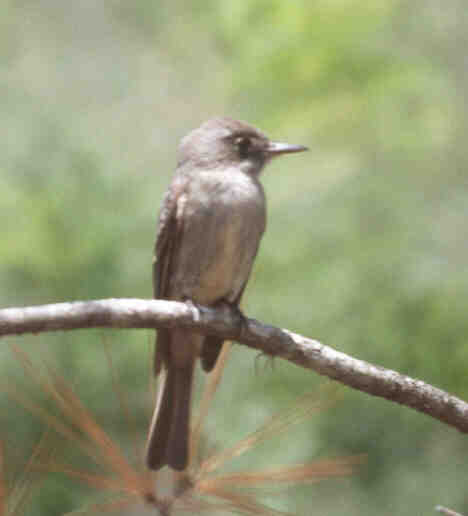
LaSagra's Flycatcher
photo © Ken McKenna, 2000
Parc Nacional Bahia De Naranjo -- Bird Sightings
8 April & 12 April 2000
| COMMON NAME | SCIENTIFIC NAME | # OBSERVED | |
| 8 April | 12 April | ||
| Least Grebe | Tachybaptus dominicus | 2 | 6 |
| West Indian Whistling-Duck | Dendrocygna arborea | - | 2 |
| Tricolored Heron | Egretta tricolor | 1 | 2 |
| Little Blue Heron | Egretta caerulea | - | 11 |
| Snowy Egret | Egretta thula | 10 | 15 |
| Great Blue Heron | Ardea herodias | 1 | 1 |
| Great Egret | Ardea alba | 2 | 2 |
| Cattle Egret | Bubulcus ibis | 30 | 50 |
| Green Heron | Butorides virescens | 6 | 1 |
| Yellow-crowned Night-Heron | Nyctanassa violacea | - | 1 |
| Turkey Vulture | Cathartes aura | 50 | 50 |
| Snail Kite | Rostrhamus sociabilis | - | 1 |
| American Kestrel | Falco sparverius | 2 | 1 |
| Common Moorhen | Gallinula chloropus | 5 | 20 |
| American Coot | Fulica americana | 4 | 5 |
| Caribbean Coot | Fulica caribaea | - | - |
| Greater Yellowlegs | Tringa melanoleuca | 1 | - |
| Solitary Sandpiper | Tringa solitaria | 2 | - |
| Black-necked Stilt | Himantopus mexicanus | 4 | 40 |
| Killdeer | Charadrius vociferus | - | 1 |
| Royal Tern | Sterna maxima | 5 | 6 |
| Rock Dove | Columba livia | 10 | 20 |
| White-crowned Pigeon | Columba leucocephala | - | 1 |
| Mourning Dove | Zenaida macroura | 25 | 25 |
| Zenaida Dove | Zenaida aurita | 4 | - |
| White-winged Dove | Zenaida asiatica | 4 | 1 |
| Common Ground-Dove | Columbina passerina | 20 | 3 |
| Mangrove Cuckoo | Coccyzus minor | - | 1 |
| Great Lizard-Cuckoo | Saurothera merlini | 3 | 2 |
| Smooth-billed Ani | Crotophaga ani | 10 | 15 |
| Cuban Emerald | Chlorostilbon ricordii | - | 6 |
| Cuban Tody | Todus multicolor | 1 | 1 |
| Cuban Woodpecker | Xiphidiopicus percussus | 6 | 3 |
| La Sagra's Flycatcher | Myiarchus sagrae | - | 1 |
| Gray Kingbird | Tyrannus dominicensis | 15 | 10 |
| Loggerhead Kingbird | Tyrannus caudifasciatus | 2 | 4 |
| Cuban Vireo | Vireo gundlachii | - | 2 |
| Black-whiskered Vireo | Vireo altiloquus | 15 | 20 |
| Red-legged Thrush | Turdus plumbeus | 10 | 10 |
| Northern Mockingbird | Mimus polyglottos | 15 | 10 |
| Cuban Martin | Progne cryptoleuca | 1 | 1 |
| House Sparrow | Passer domesticus | 10 | 15 |
| Northern Parula | Parula americana | 5 | 2 |
| Yellow Warbler | Dendroica petechia | 4 | 2 |
| Magnolia Warbler | Dendroica magnolia | - | 1 |
| Cape May Warbler | Dendroica tigrina | 5 | 4 |
| Black-throated Blue Warbler | Dendroica caerulescens | 5 | 6 |
| Prairie Warbler | Dendroica discolor | 2 | - |
| Palm Warbler | Dendroica palmarum | 4 | 1 |
| Black-and-white Warbler | Mniotilta varia | 2 | 5 |
| American Redstart | Setophaga ruticilla | 5 | 10 |
| Ovenbird | Seiurus aurocapillus | - | 1 |
| Northern Waterthrush | Seiurus noveboracensis | 1 | 1 |
| Louisiana Waterthrush | Seiurus motacilla | 1 | - |
| Common Yellowthroat | Geothlypis trichas | 2 | 2 |
| Stripe-headed Tanager | Spindalis zena | 6 | 4 |
| Red-legged Honeycreeper | Cyanerpes cyaneus | - | 2 |
| Yellow-faced Grassquit | Tiaris olivacea | 10 | 15 |
| Black-cowled Oriole | Icterus dominicensis | - | 2 |
| Tawny-shouldered Blackbird | Agelaius humeralis | 5 | 10 |
| Cuban Blackbird | Dives atroviolacea | 10 | 15 |
| Greater Antillean Grackle | Quiscalus niger | 25 | 25 |
April 9
Playa Pesquero
We took a taxi minivan to Playa Pesquero, once an undeveloped beach, but now in the throes of hotel development. Regardless, we saw some new birds during our walk along the coral rock coastline (Wilson's Plover, Reddish Egret), and Mad McKay tried to lose his watch, unsuccessfully, as it turned out. Most of the group enjoyed a swim off the incredible beach.
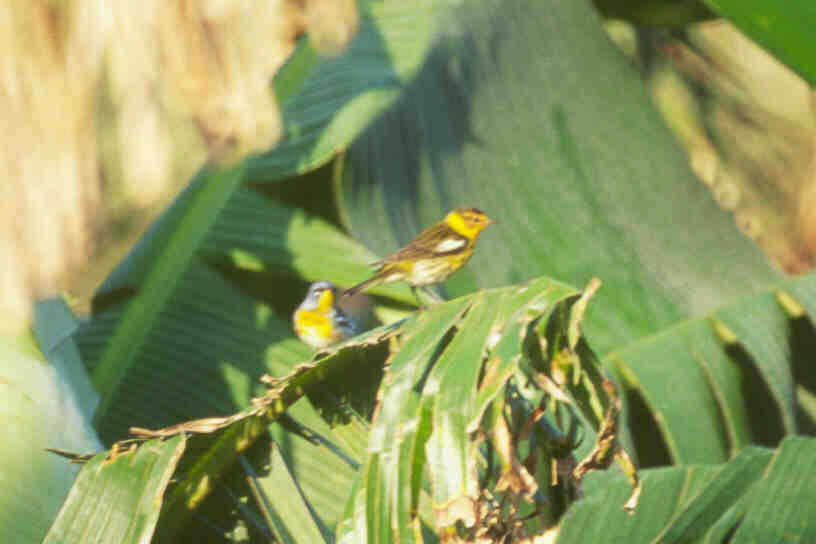
An odd combo, Cape May
Warbler & Northern Parula.
photo © Ken McKenna, 2000
Playa Pesquero -- Bird Sightings
9 April 2000
| COMMON NAME | SCIENTIFIC NAME | # SEEN |
| Reddish Egret | Egretta rufescens | 1 |
| Turkey Vulture | Cathartes aura | 15 |
| Spotted Sandpiper | Tringa macularia | 6 |
| Willet | Catoptrophorus semipalmatus | 3 |
| Ruddy Turnstone | Arenaria interpres | 6 |
| Black-bellied Plover | Pluvialis squatarola | 3 |
| Wilson's Plover | Charadrius wilsonia | 3 |
| Killdeer | Charadrius vociferus | 2 |
| Rock Dove | Columba livia | 20 |
| Mourning Dove | Zenaida macroura | 10 |
| White-winged Dove | Zenaida asiatica | 4 |
| Smooth-billed Ani | Crotophaga ani | 5 |
| Cuban Emerald | Chlorostilbon ricordii | 4 |
| Gray Kingbird | Tyrannus dominicensis | 5 |
| Cuban Vireo | Vireo gundlachii | 2 |
| Black-whiskered Vireo | Vireo altiloquus | 5 |
| Red-legged Thrush | Turdus plumbeus | 5 |
| Northern Mockingbird | Mimus polyglottos | 5 |
| House Sparrow | Passer domesticus | 10 |
| Oriente Warbler | Teretistris fornsi | 2 |
| Shiny Cowbird | Molothrus bonariensis | 1 |
April 10
A day trip to Pinares de Mayarí.
We left early in the morning, with a new guide (as Raoul was ill). South of Mayarí, going up into the mountains, we stopped at Salto del Guayabo, a virgin rainforest, watched over by a single guardian, Ermelino Napoles, who spoke only Spanish, but had a remarkable knowledge of the natural history of "his" preserve. We learned of the occurrence of some choice species, including Gray-headed and Blue-headed Quail-Doves, and Cuban Solitaires. We were there at the wrong time of day to see the doves, but we heard the Solitaires. There are also Bee Hummingbirds. This is a place to return early in the morning, but would require staying nearby, such as at the lodge at Pinares del Mayarí. There were many other birds on offer, including numerous Oriente Warblers, Olive-capped Warblers, and Cuban Bullfinches. Nearby we had extended views of soaring Broad-winged Hawks, the resident Cuban race.
We then went on to lunch at the Lodge at Pinares, (very good), and then it was off to the research station in the Pinares del Nipé National Park, where we had a great tour on a diverse nature trail, and saw a nesting Cuban (Greater Antillean) Nightjar, and Roger and the guide were lucky enough to quickly glimpse a Bee Hummingbird. Our guide was one of the park's researchers, and they are desperately short of equipment, including camera equipment. He asked us to photograph the nightjar on the nest, and document the day-old young, for a paper he has in preparation. We were pleased to do so, and have sent him the images.
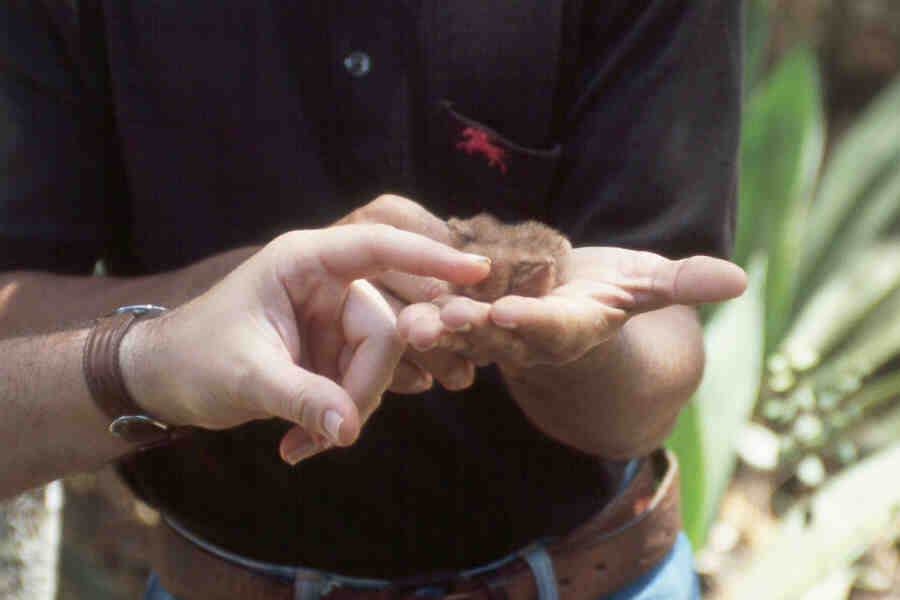
Day-old Cuban (Greater
Antillean) Nightjar chicks.
photo © Ken McKenna, 2000
There were many Cuban Todys, and we saw La Sagra's Flycatchers and Loggerhead Kingbirds. We learned that there are many other trails in the park, and that the park has a bird list of more than 150 species, as well as many orchids, and other interesting plants. Everyone who went on this trip agreed that several nights should be spent in this area, to properly explore it. We had only a tantalizing glimpse.
We were back to Guardalavaca by dark,
wishing that we could have stayed several days.
Pinares De Mayarí -- Bird Sightings
10 April 2000
| COMMON NAME | SCIENTIFIC NAME | # SEEN |
| Little Blue Heron | Egretta caerulea | 1 |
| Snowy Egret | Egretta thula | 10 |
| Cattle Egret | Bubulcus ibis | 40 |
| Green Heron | Butorides virescens | 1 |
| Turkey Vulture | Cathartes aura | 50 |
| Broad-winged Hawk | Buteo platypterus | 3 |
| American Kestrel | Falco sparverius | 3 |
| Common Moorhen | Gallinula chloropus | 1 |
| Killdeer | Charadrius vociferus | 3 |
| Rock Dove | Columba livia | 15 |
| Scaly-naped Pigeon | Columba squamosa | 1 |
| Mourning Dove | Zenaida macroura | 25 |
| Common Ground-Dove | Columbina passerina | 20 |
| Smooth-billed Ani | Crotophaga ani | 10 |
| Greater Antillean Nightjar | Caprimulgus cubanensis | 1 (+2y) |
| Cuban Emerald | Chlorostilbon ricordii | 25 |
| Bee Hummingbird | Mellisuga helenae | 1 |
| Cuban Trogon | Priotelus temnurus | 2 |
| Cuban Tody | Todus multicolor | 15 |
| Northern Flicker | Colaptes auratus | 1 |
| Cuban Pewee | Contopus caribaeus | 4 |
| La Sagra's Flycatcher | Myiarchus sagrae | 4 |
| Gray Kingbird | Tyrannus dominicensis | 15 |
| Loggerhead Kingbird | Tyrannus caudifasciatus | 3 |
| Cuban Vireo | Vireo gundlachii | 3 |
| Black-whiskered Vireo | Vireo altiloquus | 20 |
| Cuban Solitaire | Myadestes elisabeth | 3 |
| Red-legged Thrush | Turdus plumbeus | 20 |
| Northern Mockingbird | Mimus polyglottos | 25 |
| House Sparrow | Passer domesticus | 10 |
| Cape May Warbler | Dendroica tigrina | 6 |
| Black-throated Blue Warbler | Dendroica caerulescens | 20 |
| Olive-capped Warbler | Dendroica pityophila | 20 |
| Prairie Warbler | Dendroica discolor | 1 |
| Palm Warbler | Dendroica palmarum | 2 |
| Black-and-white Warbler | Mniotilta varia | 1 |
| American Redstart | Setophaga ruticilla | 10 |
| Ovenbird | Seiurus aurocapillus | 4 |
| Oriente Warbler | Teretistris fornsi | 12 |
| Stripe-headed Tanager | Spindalis zena | 4 |
| Red-legged Honeycreeper | Cyanerpes cyaneus | 6 |
| Cuban Bullfinch | Melopyrrha nigra | 20 |
| Cuban Grassquit | Tiaris canora | 20 |
| Yellow-faced Grassquit | Tiaris olivacea | 50 |
| Black-cowled Oriole | Icterus dominicensis | 1 |
| Tawny-shouldered Blackbird | Agelaius humeralis | 3 |
| Cuban Blackbird | Dives atroviolacea | 10 |
| Greater Antillean Grackle | Quiscalus niger | 25 |
April 11
Guardalavaca.
More idle birding.
April 12
Some of the group chose to return to Parc Nacional Bahia De Naranjo, where a highlight was an adult Snail Kite, and a family group of West Indian Whistling-Ducks. The ponds held a Caribbean Coot, a lifer for some in the group. The Bird List is above, under April 8.
April 13
Guardalavaca.
In the early evening we headed out to the airport, had no trouble checking in, and the flight left on time. We were reluctant to leave, but had enjoyed a splendid trip.
TRIP HIGHLIGHTS

The author coordinating the evening checklist --
"it's not easy being green".
The group insisted this shot be included. The
participants are always right.
photo © Joan Waldron, 2000
FULL LIST OF SPECIES SEEN from 1 - 13 April 2000
| COMMON NAME | SCIENTIFIC NAME |
| Least Grebe | Tachybaptus dominicus |
| Pied-billed Grebe | Podilymbus podiceps |
| Brown Pelican | Pelecanus occidentalis |
| West Indian Whistling-Duck | Dendrocygna arborea |
| Ruddy Duck | Oxyura jamaicensis |
| Reddish Egret | Egretta rufescens |
| Tricolored Heron | Egretta tricolor |
| Little Blue Heron | Egretta caerulea |
| Snowy Egret | Egretta thula |
| Great Blue Heron | Ardea herodias |
| Great Egret | Ardea alba |
| Cattle Egret | Bubulcus ibis |
| Green Heron | Butorides virescens |
| Yellow-crowned Night-Heron | Nyctanassa violacea |
| Turkey Vulture | Cathartes aura |
| Snail Kite | Rostrhamus sociabilis |
| Broad-winged Hawk | Buteo platypterus |
| Red-tailed Hawk | Buteo jamaicensis |
| Gundlach's Hawk | Accipiter gundlachi |
| Crested Caracara | Caracara plancus |
| American Kestrel | Falco sparverius |
| Peregrine Falcon | Falco peregrinus |
| King Rail | Rallus elegans |
| Purple Gallinule | Porphyrio martinicus |
| Common Moorhen | Gallinula chloropus |
| American Coot | Fulica americana |
| Caribbean Coot | Fulica caribaea |
| Limpkin | Aramus guarauna |
| Northern Jacana | Jacana spinosa |
| Greater Yellowlegs | Tringa melanoleuca |
| Lesser Yellowlegs | Tringa flavipes |
| Solitary Sandpiper | Tringa solitaria |
| Spotted Sandpiper | Tringa macularia |
| Willet | Catoptrophorus semipalmatus |
| Ruddy Turnstone | Arenaria interpres |
| Least Sandpiper | Calidris minutilla |
| Black-necked Stilt | Himantopus mexicanus |
| Black-bellied Plover | Pluvialis squatarola |
| Semipalmated Plover | Charadrius semipalmatus |
| Wilson's Plover | Charadrius wilsonia |
| Killdeer | Charadrius vociferus |
| Laughing Gull | Larus atricilla |
| Royal Tern | Sterna maxima |
| Rock Dove | Columba livia |
| White-crowned Pigeon | Columba leucocephala |
| Scaly-naped Pigeon | Columba squamosa |
| Mourning Dove | Zenaida macroura |
| Zenaida Dove | Zenaida aurita |
| White-winged Dove | Zenaida asiatica |
| Common Ground-Dove | Columbina passerina |
| Ruddy Quail-Dove | Geotrygon montana |
| Mangrove Cuckoo | Coccyzus minor |
| Great Lizard-Cuckoo | Saurothera merlini |
| Smooth-billed Ani | Crotophaga ani |
| Bare-legged Owl | Otus lawrencii |
| Cuban Pygmy-Owl | Glaucidium siju |
| Antillean Nighthawk | Chordeiles gundlachii |
| Greater Antillean Nightjar | Caprimulgus cubanensis |
| White-collared Swift | Streptoprocne zonaris |
| Antillean Palm-Swift | Tachornis phoenicobia |
| Cuban Emerald | Chlorostilbon ricordii |
| Bee Hummingbird | Mellisuga helenae |
| Cuban Trogon | Priotelus temnurus |
| Belted Kingfisher | Ceryle alcyon |
| Cuban Tody | Todus multicolor |
| West Indian Woodpecker | Melanerpes superciliaris |
| Cuban Woodpecker | Xiphidiopicus percussus |
| Northern Flicker | Colaptes auratus |
| Eastern Wood-Pewee | Contopus virens |
| Cuban Pewee | Contopus caribaeus |
| La Sagra's Flycatcher | Myiarchus sagrae |
| Eastern Kingbird | Tyrannus tyrannus |
| Gray Kingbird | Tyrannus dominicensis |
| Loggerhead Kingbird | Tyrannus caudifasciatus |
| Cuban Crow | Corvus nasicus |
| Cuban Vireo | Vireo gundlachii |
| Black-whiskered Vireo | Vireo altiloquus |
| Warbling Vireo | Vireo gilvus |
| Cuban Solitaire | Myadestes elisabeth |
| Red-legged Thrush | Turdus plumbeus |
| Gray Catbird | Dumetella carolinensis |
| Northern Mockingbird | Mimus polyglottos |
| Cuban Martin | Progne cryptoleuca |
| Northern Rough-winged Swallow | Stelgidopteryx serripennis |
| Bank Swallow | Riparia riparia |
| Barn Swallow | Hirundo rustica |
| Cliff Swallow | Hirundo pyrrhonota |
| Cave Swallow | Hirundo fulva |
| House Sparrow | Passer domesticus |
| Northern Parula | Parula americana |
| Yellow Warbler | Dendroica petechia |
| Magnolia Warbler | Dendroica magnolia |
| Cape May Warbler | Dendroica tigrina |
| Black-throated Blue Warbler | Dendroica caerulescens |
| Blackburnian Warbler | Dendroica fusca |
| Yellow-throated Warbler | Dendroica dominica |
| Olive-capped Warbler | Dendroica pityophila |
| Prairie Warbler | Dendroica discolor |
| Palm Warbler | Dendroica palmarum |
| Black-and-white Warbler | Mniotilta varia |
| American Redstart | Setophaga ruticilla |
| Worm-eating Warbler | Helmitheros vermivorus |
| Ovenbird | Seiurus aurocapillus |
| Northern Waterthrush | Seiurus noveboracensis |
| Louisiana Waterthrush | Seiurus motacilla |
| Common Yellowthroat | Geothlypis trichas |
| Oriente Warbler | Teretistris fornsi |
| Hooded Warbler | Wilsonia citrina |
| Stripe-headed Tanager | Spindalis zena |
| Red-legged Honeycreeper | Cyanerpes cyaneus |
| Cuban Bullfinch | Melopyrrha nigra |
| Cuban Grassquit | Tiaris canora |
| Yellow-faced Grassquit | Tiaris olivacea |
| Indigo Bunting | Passerina cyanea |
| Painted Bunting | Passerina ciris |
| Black-cowled Oriole | Icterus dominicensis |
| Tawny-shouldered Blackbird | Agelaius humeralis |
| Eastern Meadowlark | Sturnella magna |
| Cuban Blackbird | Dives atroviolacea |
| Greater Antillean Grackle | Quiscalus niger |
| Shiny Cowbird | Molothrus bonariensis |
The Nova Scotia Bird
Society tour of Cuba
photo © Joan Waldron, 2000
Blake Maybank
Nova Scotia, Canada
maybank@birdingtheamericas.com